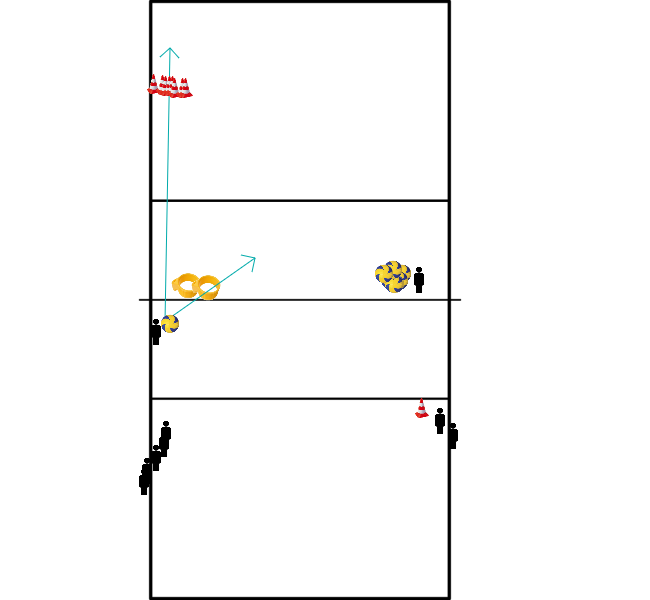Volleyball drills
- trio one ball and a tennis ball.
- when the person has played overhand
- throw the tennisball to the middle
- 'Chaos Easy' starts as a warm-up, but ends as a real battle.
- The players are put in the field (it doesn't matter where).
- The ball is caught and immediately thrown over the net (one play).
- As the player catches, he throws the ball.
- When a player has thrown the ball, he/she goes to a wall (back of the field or on the side) and taps it, then comes back into the field.
- The other players on the team have moved forward one spot.
- You notice how difficult it is to score.
- When someone throws the wrong ball (into the net or out), he/she has to sprint around the opponent's field.
- the number of players present are all outside the field of play.
- In the middle of the field there is a hoop with a number of balls in it.
- 1 less than the number of players
- Players do a number of exercises, for example
- planking
- sit-ups
- push-ups.
- when the players have completed these exercises, they lie on their backs.
- At the sign of the trainer they run to the middle, and try to conquer a ball.
- They keep on running until there is only one ball left.
- The winner of the game decides on a punishment for the other players.
- Exercise with two blockers, opposite each other at the net, and a defender.
- The ball is thrown in just over the net edge.
- The task of the blocker on the opposite side is to score with two hands above the net in one of the hoops you have placed at the side lines.
- The blocker and defender on their own side agree on which side they will block and defend (think beach volleyball).
- Put 6 hoops down, on the 6 positions. (P1 t/m 6).
- Make 2 fair teams, easiest is from 4 players per team.
- One person from each team starts in the hoop at position 1.
- The rest of the team stands with a ball on the other side of the hoop, behind the back line and vice versa.
- As soon as the trainer indicates it, both teams start serving on the hoops.
- The person standing in the hoop tries to catch the service without stepping out of the hoop.
- When a service is caught, the person who served the ball moves to position 2, to catch the ball in the hoop.
- The person who was in position 1 goes to his own backline to serve.
- The team that catches the ball first at position 6 is the winner.
- Important is to concentrate on a good service every time.
- The goal of this exercise is to tactically put away or hit the ball.
- This by means of a tap ball on midmid, or a ball deep on position 1.
- By using baskets you can create a 'constant' block, which eventually can be replaced by a real block.
- The pawns at position 1 can best be replaced by a cupboard, over which the ball must fall, over the 'defender'.
- The trainer hits a ball, or plays a ball in, which is first passed to the distributor,
- the playmaker gives a set-up to the outside.
- The attacker decides whether to try a short passed ball at midmid (where there is a hoop),
- or looks for position 1 with a hit or a fast overhand ball.

- Play fanatically in pairs
- Make long series.
- Is that going well?
- Try to hit the ball quietly every now and then.
- Coach throws from the net:
- 3 players on the backline on their stomachs.
- Trainer hits the ball,
- 3 players stand up and trainer attacks/plays.
- Nr. 1 of the trio defends,
- No. 2 sets up and
- No. 3 attacks
- then next 3 team
- One player is tagged.
- When you are tagged, sit against the wall with one arm up. NOTE: legs in an angle of 90 degrees.
- When someone sits on your lap (=toilet) and "pulls" on your arm, you are free again.
- Change your ticker regularly.
- Make three pairs
- the middle one plays backwards.
- All on the back line
- two walk to the net
- make a block jump
- and go backwards again
- the coach puts the ball in play
- and they set up an attack.
- 5-minute laps around the field.
- Hamstring stretch.
- Ankle stretch.
- Groin stretch.
- Back stretch,
- Stand tall,
- step by step, hands on toes, starting with the chin on the chest.
- Then slowly go down to the toes.
- When the toes have been touched, slowly lift up and stretch all the way again.
- Planks on two elbows 3x20sec
- Planks on the side 2x20 left 2x20 right
- Push up 2x10
- Abdominals 2x10 Move elbows to knees.
- Warm up with ball








